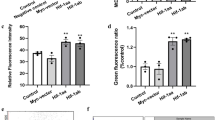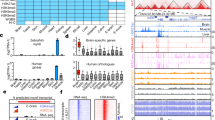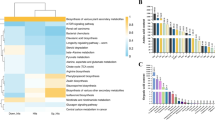Abstract
Here we investigate the function of zebrafish Bcl-2 family proteins and demonstrate important conservation of function across zebrafish and mammalian systems. We have isolated a zebrafish ortholog of mammalian BIM and show that it is the most toxic of the zebrafish BH3-only genes examined, sharing this characteristic with the mammalian BIM gene. The zebrafish bad gene shows a complete lack of embryonic lethality, but like mammalian BAD, its pro-apoptotic activity is regulated through phosphorylation of critical serines. We also found that the pattern of mitochondrial dysfunction observed by zebrafish BH3 domain peptides in a mammalian cytochrome c release assay recapitulates the pattern of embryonic lethality induced by the respective mRNA injections in vivo. In contrast to zebrafish Bim, Bid exhibited only weak binding to zebrafish Bcl-2 and moderate-to-weak overall lethality in zebrafish embryos and isolated mitochondria. Given that zebrafish Bcl-2 binds strongly to mammalian BID and BIM peptides and proteins, the protein identified as the zebrafish Bid ortholog has different properties than mammalian BID. Overall, our results demonstrate the high degree of functional conservation between zebrafish and mammalian Bcl-2 family proteins, thus validating the zebrafish as a model system to further dissect the molecular mechanisms that regulate apoptosis in future forward genetic and chemical modifier screens.
Similar content being viewed by others
Log in or create a free account to read this content
Gain free access to this article, as well as selected content from this journal and more on nature.com
or
Abbreviations
- BH:
-
Bcl-2 homology
- IRR:
-
irradiation
- hpf:
-
hours post-fertilization
References
Cory S, Adams JM . The Bcl2 family: regulators of the cellular life-or-death switch. Nat Rev Cancer 2002; 2: 647–656.
Danial NN, Korsmeyer SJ . Cell death: critical control points. Cell 2004; 116: 205–219.
Kelekar A, Thompson CB . Bcl-2-family proteins: the role of the BH3 domain in apoptosis. Trends Cell Biol 1998; 8: 324–330.
Puthalakath H, Strasser A . Keeping killers on a tight leash: transcriptional and post-translational control of the pro-apoptotic activity of BH3-only proteins. Cell Death Differ 2002; 9: 505–512.
Boyd JM, Gallo GJ, Elangovan B, Houghton AB, Malstrom S, Avery BJ et al. Bik, a novel death-inducing protein shares a distinct sequence motif with Bcl-2 family proteins and interacts with viral and cellular survival-promoting proteins. Oncogene 1995; 11: 1921–1928.
Wei MC, Zong WX, Cheng EH, Lindsten T, Panoutsakopoulou V, Ross AJ et al. Proapoptotic BAX and BAK: a requisite gateway to mitochondrial dysfunction and death. Science 2001; 292: 727–730.
Zong WX, Lindsten T, Ross AJ, MacGregor GR, Thompson CB . BH3-only proteins that bind pro-survival Bcl-2 family members fail to induce apoptosis in the absence of Bax and Bak. Genes Dev 2001; 15: 1481–1486.
Kuwana T, Bouchier-Hayes L, Chipuk JE, Bonzon C, Sullivan BA, Green DR et al. BH3 domains of BH3-only proteins differentially regulate Bax-mediated mitochondrial membrane permeabilization both directly and indirectly. Mol Cell 2005; 17: 525–535.
Letai A, Bassik MC, Walensky LD, Sorcinelli MD, Weiler S, Korsmeyer SJ . Distinct BH3 domains either sensitize or activate mitochondrial apoptosis, serving as prototype cancer therapeutics. Cancer Cell 2002; 2: 183–192.
Green DR, Kroemer G . The pathophysiology of mitochondrial cell death. Science 2004; 305: 626–629.
Wang X . The expanding role of mitochondria in apoptosis. Genes Dev 2001; 15: 2922–2933.
Cheng EH, Levine B, Boise LH, Thompson CB, Hardwick JM . Bax-independent inhibition of apoptosis by Bcl-XL. Nature 1996; 379: 554–556.
Cheng EH, Wei MC, Weiler S, Flavell RA, Mak TW, Lindsten T et al. BCL-2, BCL-X(L) sequester BH3 domain-only molecules preventing BAX- and BAK-mediated mitochondrial apoptosis. Mol Cell 2001; 8: 705–711.
Certo M, Del Gaizo Moore V, Nishino M, Wei G, Korsmeyer S, Armstrong SA et al. Mitochondria primed by death signals determine cellular addiction to antiapoptotic BCL-2 family members. Cancer Cell 2006; 9: 351–365.
Chen L, Willis SN, Wei A, Smith BJ, Fletcher JI, Hinds MG et al. Differential targeting of prosurvival Bcl-2 proteins by their BH3-only ligands allows complementary apoptotic function. Mol Cell 2005; 17: 393–403.
Opferman JT, Korsmeyer SJ . Apoptosis in the development and maintenance of the immune system. Nat Immunol 2003; 4: 410–415.
Coultas L, Huang DC, Adams JM, Strasser A . Pro-apoptotic BH3-only Bcl-2 family members in vertebrate model organisms suitable for genetic experimentation. Cell Death Differ 2002; 9: 1163–1166.
Inohara N, Nunez G . Genes with homology to mammalian apoptosis regulators identified in zebrafish. Cell Death Differ 2000; 7: 509–510.
Pyati UJ, Look AT, Hammerschmidt M . Zebrafish as a powerful vertebrate model system for in vivo studies of cell death. Semin cancer biol 2007; 17: 154–165.
Kratz E, Eimon PM, Mukhyala K, Stern H, Zha J, Strasser A et al. Functional characterization of the Bcl-2 gene family in the zebrafish. Cell Death Differ 2006; 13: 1631–1640.
Ley R, Balmanno K, Hadfield K, Weston C, Cook SJ . Activation of the ERK1/2 signaling pathway promotes phosphorylation and proteasome-dependent degradation of the BH3-only protein, Bim. J Biol Chem 2003; 278: 18811–18816.
Luciano F, Jacquel A, Colosetti P, Herrant M, Cagnol S, Pages G et al. Phosphorylation of Bim-EL by Erk1/2 on serine 69 promotes its degradation via the proteasome pathway and regulates its proapoptotic function. Oncogene 2003; 22: 6785–6793.
Qi XJ, Wildey GM, Howe PH . Evidence that Ser87 of BimEL is phosphorylated by Akt and regulates BimEL apoptotic function. J Biol Chem 2006; 281: 813–823.
Puthalakath H, Huang DC, O′Reilly LA, King SM, Strasser A . The proapoptotic activity of the Bcl-2 family member Bim is regulated by interaction with the dynein motor complex. Mol Cell 1999; 3: 287–296.
Detrich III HW, Westerfield M, Zon LI . Cell cycles and development in the embryonic zebrafish. Methods Cell Biol 1999; 59: 11–26.
Mok CL, Gil-Gomez G, Williams O, Coles M, Taga S, Tolaini M et al. Bad can act as a key regulator of T cell apoptosis and T cell development. J Exp Med 1999; 189: 575–586.
Seo SY, Chen YB, Ivanovska I, Ranger AM, Hong SJ, Dawson VL et al. BAD is a pro-survival factor prior to activation of its pro-apoptotic function. J Biol Chem 2004; 279: 42240–42249.
Datta SR, Katsov A, Hu L, Petros A, Fesik SW, Yaffe MB et al. 14-3-3 proteins and survival kinases cooperate to inactivate BAD by BH3 domain phosphorylation. Mol Cell 2000; 6: 41–51.
Certo M, Moore Vdel G, Nishino M, Wei G, Korsmeyer S, Armstrong SA et al. Mitochondria primed by death signals determine cellular addiction to antiapoptotic BCL-2 family members. Cancer Cell 2006; 9: 351–365.
Cheng EH, Levine B, Boise LH, Thompson CB, Hardwick JM . Bax-independent inhibition of apoptosis by Bcl-XL. Nature 1996; 379: 554–556.
Cheng EH, Wei MC, Weiler S, Flavell RA, Mak TW, Lindsten T et al. BCL-2, BCL-X(L) sequester BH3 domain-only molecules preventing BAX- and BAK-mediated mitochondrial apoptosis. Mol Cell 2001; 8: 705–711.
Letai A, Bassik MC, Walensky LD, Sorcinelli MD, Weiler S, Korsmeyer SJ . Distinct BH3 domains either sensitize or activate mitochondrial apoptosis, serving as prototype cancer therapeutics. Cancer Cell 2002; 2: 183–192.
Green DR, Evan GI . A matter of life and death. Cancer Cell 2002; 1: 19–30.
Bouillet P, Metcalf D, Huang DC, Tarlinton DM, Kay TW, Kontgen F et al. Proapoptotic Bcl-2 relative Bim required for certain apoptotic responses, leukocyte homeostasis, and to preclude autoimmunity. Science 1999; 286: 1735–1738.
O′Connor L, Strasser A, O′Reilly LA, Hausmann G, Adams JM, Cory S et al. Bim: a novel member of the Bcl-2 family that promotes apoptosis. EMBO J 1998; 17: 384–395.
Gross A, Yin XM, Wang K, Wei MC, Jockel J, Milliman C et al. Caspase cleaved BID targets mitochondria and is required for cytochrome c release, while BCL-XL prevents this release but not tumor necrosis factor-R1/Fas death. J Biol Chem 1999; 274: 1156–1163.
Li H, Zhu H, Xu CJ, Yuan J . Cleavage of BID by caspase 8 mediates the mitochondrial damage in the Fas pathway of apoptosis. Cell 1998; 94: 491–501.
Langenau DM, Jette C, Berghmans S, Palomero T, Kanki JP, Kutok JL et al. Suppression of apoptosis by bcl-2 overexpression in lymphoid cells of transgenic zebrafish. Blood 2005; 105: 3278–3285.
Shaner NC, Campbell RE, Steinbach PA, Giepmans BN, Palmer AE, Tsien RY . Improved monomeric red, orange and yellow fluorescent proteins derived from Discosoma sp. red fluorescent protein. Nat Biotechnol 2004; 22: 1567–1572.
Acknowledgements
Funding for this work was provided by V foundation (AMF), and NIH grants RO1CA119066 (ATL), KO1DK0745551 by the National Institute of Diabetes and Digestive and Kidney Diseases (CAJ), 5T32HL07623-20 (UJP), K08CA10254 (AL), P01CA068484 (AL and ATL), and K99NS058608 (RAS). DML is the Safra Foundation Fellow from the Irvington Institute for Immunology. AL is a founder and member of the Scientific Advisory Board for Eutropics Pharmaceuticals.
Author information
Authors and Affiliations
Corresponding authors
Additional information
Edited by RA Knight
Rights and permissions
About this article
Cite this article
Jette, C., Flanagan, A., Ryan, J. et al. BIM and other BCL-2 family proteins exhibit cross-species conservation of function between zebrafish and mammals. Cell Death Differ 15, 1063–1072 (2008). https://doi.org/10.1038/cdd.2008.42
Received:
Accepted:
Published:
Issue date:
DOI: https://doi.org/10.1038/cdd.2008.42
Keywords
This article is cited by
-
BCL-G: 20 years of research on a non-typical protein from the BCL-2 family
Cell Death & Differentiation (2023)
-
Comparative Transcriptome Analysis of Head Kidney of Aeromonas hydrophila-infected Hypoxia-tolerant and Normal Large Yellow Croaker
Marine Biotechnology (2022)
-
Disassembly of dying cells in diverse organisms
Cellular and Molecular Life Sciences (2019)
-
All in one theranostic nanoplatform enables efficient anti-tumor peptide delivery for triple-modal imaging guided cancer therapy
Nano Research (2019)
-
A structural investigation of NRZ mediated apoptosis regulation in zebrafish
Cell Death & Disease (2018)



